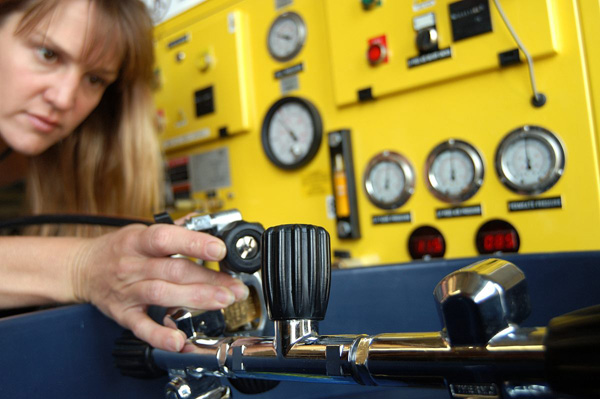
The dive shop I was visiting was a madhouse and the understaffed crew was trying their best to accommodate all the customers who were mobbing the fill station. Enriched air nitrox (EANx), trimix (helium, oxygen, and nitrogen) and standard air were all being pumped at once. On top of this already hectic scene KABLANG – down went a kicked over rental tank against the concrete floor making more then a few of us jump.
About this time, I noticed one of the EANx fill whips was connected to a non-marked older steel 71.2ft3. As EANx has become commonplace, the gas identification protocols have been diluted to the point where often just a small piece of masking tape is used to identify the gas contents with in the cylinder. Be that as it may, I did not see even this small marking on the tank. Not being sure, I waited until the customer picked up his “72” and I asked him how he liked nitrox. He proceeded to give me a three-minute diatribe on how useless it is and just a waste of money when air was all you needed. I pointed out to him that I thought a 36% nitrox fill whip might have been used by mistake to fill his tank. Upon testing, sure enough, that’s what happened. He was understandably upset.
If he was planning on diving below 110 feet he could’ve been in big trouble. Fortunately this type of error rarely happens, but it only has to happen once to ruin your day. As it turns out, one of the shop’s regular customers was trying to help out and had hooked up the wrong fill whip to this gentleman’s cylinder.
Words & Photos by Joe Dovala, Dovala Images
Since the first semi-reliable hand air pumps of the mid 1700’s, the technology to deliver a diver’s breathing gas has undergone considerable change but not to the extent we have seen in the last five years or so. Now that “technical” or extended range diving has gone mainstream there has been an explosion of new equipment available for the sport diver. Nitrox for example was considered a very advanced mix not too long ago, and many industry “experts” proclaimed that its use was too technical for recreational divers. Well, it is now becoming difficult to find a dive operation that does not supply EANx and portable EANx compressors are easily obtainable. Today’s properly trained diver has many choices when it comes to filling their cylinders besides standard air. This article will focus on some of the gas delivery systems available today and what is commonplace at dive facilities.
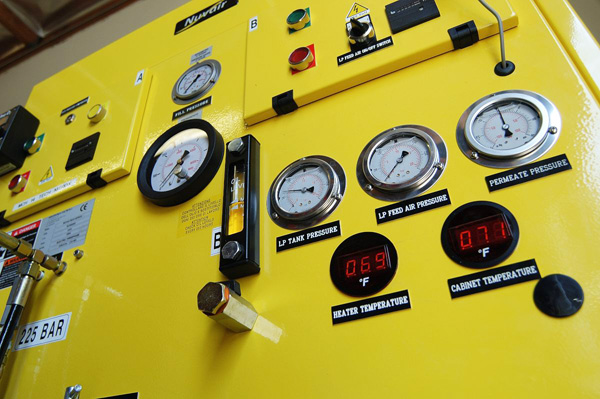
It has been said that the heart of any dive operation is the breathing gas compressor. Probably few would argue the point, but what happens on the other end of the fill whip is a mystery for many divers. While there are many designs of compressors our primary interest here is with high-pressure units. Low-pressure systems are used in conjunction with other devices or feed the diver with air directly such as a surface supplied hookah unit. High-pressure machines are multi stage compressors that typically use from three to six stages of compression. When in compression each successive stage increases its incoming pressure. That is, as the pressurized gas moves from one piston stage to the other its relative pressure is increased. The pistons move up into the compressor cylinders thereby decreasing the internal volume and raising the pressure. One-way valves are used to prevent a backflow of gas. In this matter, the compressor is able to continually add gas creating higher and higher pressure into a receiving SCUBA tank, or the facilities bank system, until the desired level has been met.
Besides the compression mechanism, a number of other very important components need to be functioning as well to provide safe clean breathing gas. Moisture separators, backpressure regulators, and a series of inlet/discharge filters, all work in concert with the compressor. The condition and type of filters are exceedingly important for good breathing gas quality. Incoming air needs to be as free of pollutants as possible so the filtration system is not over whelmed.
Remember, air has two main gases associated with it: Oxygen (O2) and nitrogen (N2). There are also a variety of trace gases mixed in as well. These include carbon dioxide, argon, neon, helium, and hydrogen, to name a few. Most of these gases exist in such small amounts that they can be ignored. Carbon dioxide (CO2) of course can exist in significant amounts due to normal respiration and effects of pollution. Urban areas tend to contribute more particulates and waste gases into the available ambient atmosphere, but dive boats and compressor shacks can have issues if they do not have adequate ventilation. Under most conditions CO2 is not a concern when using a compressor. However there are other poisonous gasses, such as carbon monoxide (a by-product of incomplete combustion of hydrocarbons) that have to be either considerably minimized or eliminated from the gas flow to the diver’s tank.
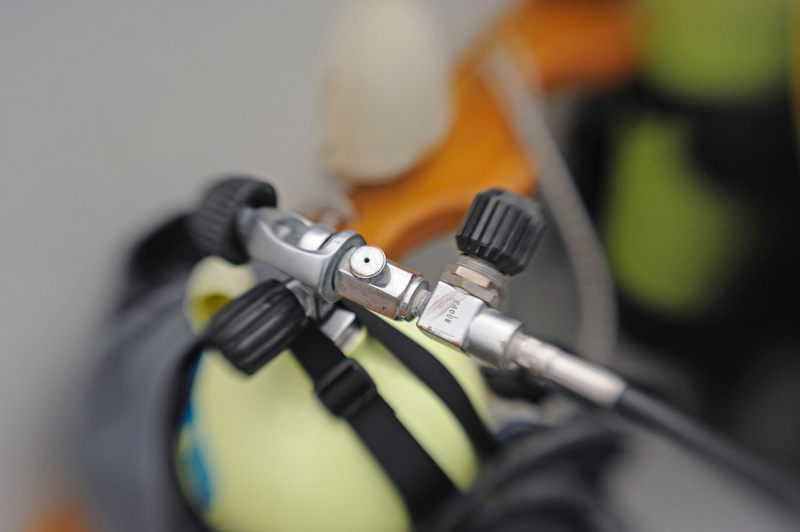
Remember Daltons Law of partial pressures? If even a small amount of carbon monoxide (CO) were added to a fill there could be dire consequences at depth. Hemoglobin has an affinity for CO about 200 times more than oxygen. As CO circulates through out the body more and more hemoglobin will be bound up with CO and unable to deliver O2 for cellular respiration. Respiration may continue within limits because the partial pressure of O2 is high enough to compensate for the reduced hemoglobin available. However once near the surface and the partial pressure of O2 returns to a more normal level there may not be enough for respiration and black out could occur. In addition, compressors themselves can add undesirable contaminates. CO can enter a diving tank through poorly located air inlet position or partial combustion of inappropriate substances, such as incorrect lube oil or an exhaust leak, within the compressor.
Fortunately CO contamination is very rare and as long as you patronize a responsible facility there won’t likely be any problems with this dangerous gas. Oil residue from the lubrication process and small metal particles from friction can also enter the gas flow due to lack of service. Oil-less compressors are readily available but tend to be more expensive and generally require much higher maintenance than with a comparable oil cooled unit. As long as the filters are maintained properly and additional service requirements are met, the oil residue and other particulates are kept well within safe limits (see sidebar). Breathing gas compressor up-keep is not a trivial matter and the next time you pay only a few bucks for a good clean air fill, be thankful, as the fees do not even cover the standard maintenance costs let alone the high initial investment in the entire system. While almost all recreational SCUBA requires at least some standard compressed air to be added to the breathing mix, there are other ways to add additional gas besides compressors.
Partial pressure blending has been around for a long time and is still the technique of choice at many fill stations. It uses the simple premise that gases will move “down hill” or flow from a container of higher pressure to one that is of lower pressure. In recreational diving it is primarily used for EANx and trimix cylinder filling with helium (He). The principal of partial pressure blending is quite straightforward: the gas of choice is transferred from a high pressure/volume storage vessel to the empty breathing tank at a controlled rate to a predetermined pressure. Often, though not always, air is compressed on “top” of this transfer and the desired mix/pressure is achieved.
While partial pressure blending can be done with a simple transfill hose and a gauge, it is not terribly gas efficient due to the relative high pressures in scuba tanks. Obviously, when the pressure equalizes between the storage vessel and the scuba cylinder gas transfer will stop. One method to deal with this problem is called cascade filling. The tank needing to be filled is first connected to the lowest pressure storage bottle, after equalization is reached, the next lowest pressure storage bottle is coupled to it until the pressures equalize, then to the next and so on. This does use more of the available storage gas but still leaves a significant amount behind. At this point the storage cylinders are returned to the gas supply company for refilling, or a device called a booster pump, can be utilized to extract the remaining supply gas out and transfer it to the SCUBA tank.
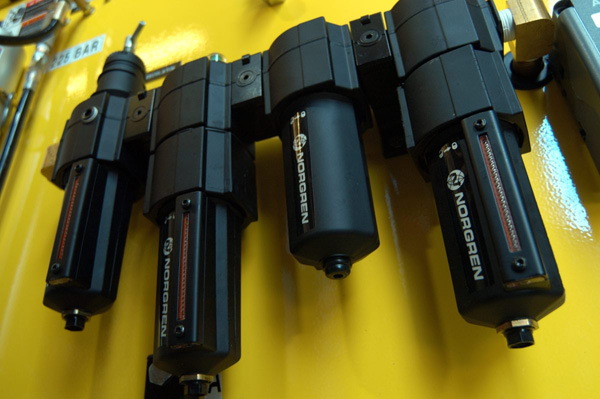
Booster pumps are small compressors driven by low-pressure input air either from another compressor or storage banks. Essentially a larger area piston, driven by the input low-pressure air, drives a smaller area compression piston that converts the input gas (gas which is in a storage tank) of choice to higher pressures. For example, if you were filling a diving cylinder with O2 from a large storage bottle and the pressure between the two were now equalized, or the storage tank had less pressure, a booster pump could be utilized to “boost” the O2 pressure in the supply bottle and compress it on top of the gas already in the SCUBA tank. In this way it is possible to use virtually all the contents of the supply cylinder. Many operations use booster pumps, but not all, as they are quite expensive and do require additional maintenance. Generally, you will find boosters in facilities that do a lot of helium filling, as He is considerably more costly then O2. In addition, there are also some very significant issues that need to be addressed whenever handling oxygen systems.
Regardless of the methodology, high pressure/high percentage O2 mixing and filling is not a trivial matter. In recreational diving, a mix is considered “high O2” if the percentage of oxygen is above 40%. Strict protocols need to be followed to avoid the potential for catastrophic accidents. High percentages of O2 (especially 80% or higher) can be explosive when handled improperly. Inappropriate components in the filling station such as standard air valves, fittings, rubber o-rings, etc can be a fuel source for an oxygen fire. Even if all equipment is certified for O2 service, contaminates such as dirt, hydrocarbon based grease, or solvents can also conspire to cause problems. Technique is equally important, not only to ensure that the correct mix of gas is achieved but also to minimize the ill effects from filling too fast or improper assembly of the equipment. If the gas flow piping is poorly laid out or the O2 is allowed to transfer too quickly, a process known as adiabatic compression can occur.
When a gas flows from higher pressure to lower pressure and then strikes an obstruction (large angle bend in piping, valve seat, etc) the gas molecules are rapidly recompressed and the temperature at this location rapidly increases. So much so that it can reach above 1500°F. Adiabatic compression is a very dangerous situation as even proper O2 service equipment can ignite under these circumstances. Learning gas-mixing methods is best accomplished through the tutelage of a qualified gas-blending instructor and not by trail and error!
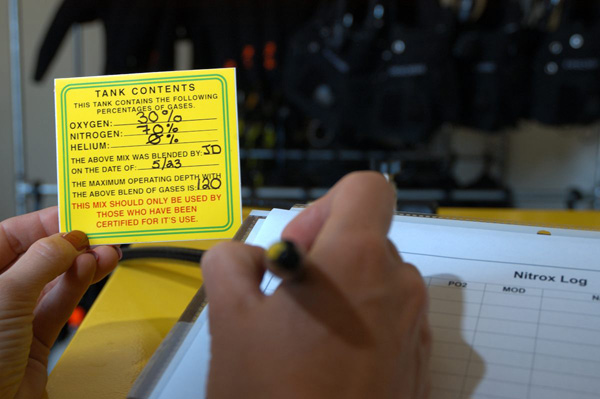
By far, most EANx fills for sport diving require less than 40% O2, and it is possible to avoid using any high oxygen sources at the fill station for these applications. EANx semi-permeable membranes have hit the market in big way. Virtually any output size system can be obtained from a small 3.5cuft/min portable compressor to commercial systems of 40cuft/min and beyond. The semi-permeable membrane is actually a large bundle of hollow fibers that allows oxygen to “permeate” through the fibers faster than nitrogen. Due to effects of molecular physics the nitrogen molecule’s diameter is larger so you can effectively say the N2 is “filtered” out. Typically a standard air compressor or air bank system feeds the membrane with low-pressure supply air. This air is heated to a temperature that is optimal for best oxygen filtration. By increasing the flow (within certain parameters) of heated supply air across the membrane an increase of the O2 percentage will occur. The excess nitrogen is vented to the atmosphere and the oxygen elevated breathing mix is compressed by the high-pressure compressor and transferred to the SCUBA cylinder. With this system there is no need to worry about handling high pressure/high % O2 during any of the process. As long as there is no need for higher O2 mixes then 40%, the semi-permeable membrane (with a high pressure compressor) can take care of the EANx needs of a fill station.
Admittedly, this is a very brief synopsis on gas compression and SCUBA cylinder filling. There are a bewildering number of gas pumping machines that can be readily acquired by an interested diver. Any kind of system can be built depending on the needs and the size of the pocket book. Deciding to pump one’s own diving cylinder with gas should be based on more than wanting convenience at home. Attention to detail and strict adherence to preventative maintenance protocols are required of the home brewer just like at the professional dive facility. While someone may get away with cutting corners a hundred times, the hundred and first could be the one that bites. It is serious business and has to be treated with respect. For most of us it is better to let the skilled operators at our favorite dive center handle this part of our undersea exploration. However, for the person who has carefully weighed out the pros and cons, invested in proper training, carefully evaluated equipment needs, then there is no time like the present to take one for a spin and fill ‘er up.
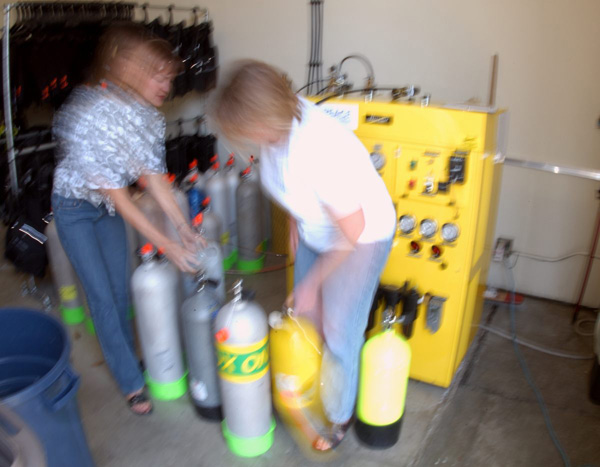
Gas standards and industry regulation
There are a number of organizations that have fashioned gas standards for their members to follow. Occupational Safety and Health Administration (OSHA) and the United States Navy are but two groups who have very detailed gas analysis requirements. In the sport diving industry, protocols of the Compressed Gas Association (CGA), made up of hundreds of member companies, are used as templates for safe gas production and handling. In reality, the set of rules are very similar in allowances for impurities and gas usage across associations.
Scuba compressors should produce Grade E air at output. That is, analysis needs to show no more than the following levels of chief contaminates (there are others but we will only concern ourselves with these few):
Carbon Monoxide ≤ 10 parts per million (ppm)
Hydrocarbon contaminates ≤ 5 milligrams per cubic meter mg/m3
Carbon Dioxide < 1000 ppm
As clean as Grade E air is, it is not sufficient for Oxygen Compatible Air (OCA). Through a process called hyper-filtration additional amounts of impurities can be eliminated. When Grade E air is “Hyper-filtered” it is called modified Grade E and is then suitable for mixing with high percentage oxygen gas. The main differences are:
Carbon Monoxide ≤ 2 ppm
Hydrocarbon contaminates ≤ 0.1 mg/m3
Carbon Dioxide < 500 ppm
Odor should not be detectable in either type. To verify that the above levels are not exceeded, responsible dive facilities have their compressor gas tested quarterly by a certified analytical laboratory. It is in the best interest of a breathing gas supplier to regularly have their air analyzed. Some states and scuba training organizations mandate such a test for their facilities. However, as in many self-governed endeavors, there will always be a few who will not participate. If a current analysis spec sheet is not displayed near the fill station ask to see it. If it cannot be produced it would be wise to take your business elsewhere.
Words & Photos by Joe Dovala, Dovala Images
